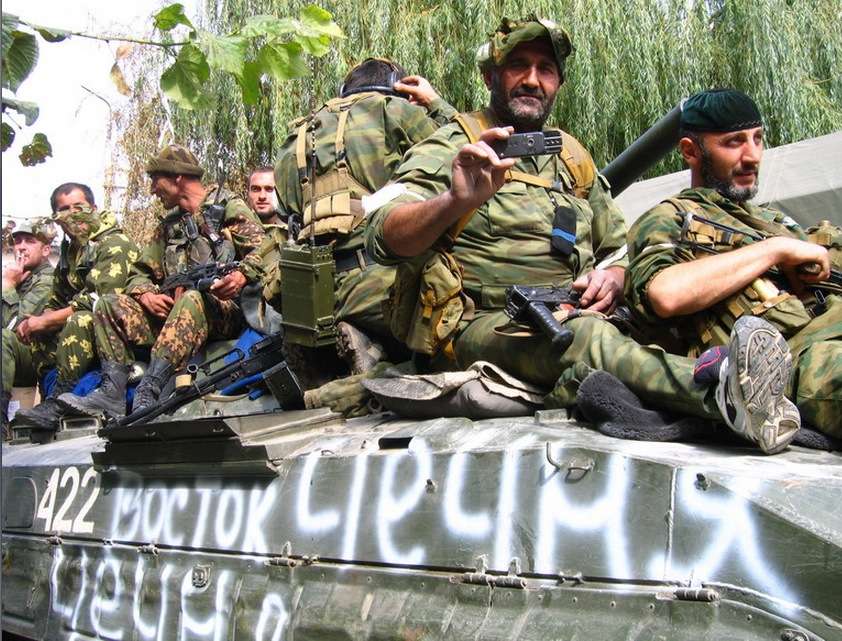Related: Army of marauders: the long history of Russian military looting, pillaging, and stealing
The first to break this tradition was the regional head of Chechnya, Ramzan Kadyrov. The unique position of this politician in today’s Russia comes from his own combination of hawkish Kremlin imperialism and local nationalism. Kadyrov has already sent several “volunteer battalions” from Chechnya to Ukraine, though some doubt that members’ participation in these units is anything but voluntary. The historical precedent of World War I should be remembered here, when the “Native (or Savage) Division” was created, consisting of Caucasian Muslims who were not recruited into the Russian army (Nezavisimoye voyennoye obozreniye, July 14). However, after the fall of Tsardom in February 1917, many volunteers of this division began to create and defend their own independent republics. The creation of ethno-regional units clearly shows the critical situation in the Russian imperial army, since such units deprive the armed forces of uniform standards and sometimes even a common language. Following Kadyrov, the leaders of other Russian regions, on apparent orders from the Kremlin, have set about forming their own volunteer battalions for the war in Ukraine. The authorities attract only local residents to them and give the battalions names associated with local heroes, toponyms, native languages and other regional specifics: “Vyatka” in Kirov Oblast, “Parma” in Perm Krai, “Tiger” in the Far East, “Alga” and “Timer” in Tatarstan, “Onego” and “Ladoga” in Karelia, a battalion named after Mimazovich Shaimuratov in Bashkortostan, and so forth. In the latter case, it is significant that the Bashkir battalion was given the name not of historical fighters for independence but that of a Soviet-era general. However, all regional divisions have their own insignia: special chevrons and their own flags. Volunteers are offered a monthly income of up to 300,000 rubles along with various benefits (Business-gazeta.ru, June 23; Vlad.mk.ru, July 9). Abbas Gallyamov, a former speechwriter for Russian President Vladimir Putin and now an opposition political scientist, believes that this process is an attempt by Russian authorities to arouse mass complicity in the Kremlin’s politics among citizens: “Now the inhabitants of many regions, especially national republics, think that what is happening in Ukraine is someone else’s war. The conditional Bashkir perceives it as a war of Russians against Ukrainians. At best, he takes a neutral position on this matter and maybe even sympathizes with the Ukrainians.” But the Putin regime has already started actual mobilization at the regional level. And Gallyamov expresses fears that “the strengthening of regional, especially ethnic identity in the context of a general increase in protest moods, will inevitably lead to an increase in separatist sentiments” (Verstka.media, June 22).Related: Challenges to Russian arms resupply: tanks, combat aviation, artillery ammunition
But observing the creation of regional battalions in Karelia, where the population of indigenous Finno-Ugric people is quite small, as well as in other Russian oblasts and krais, regional authorities obviously do not seek to build these units precisely along ethnic lines. Although a recent slip by the Karelian military commissar is extremely revealing: “The formation of volunteer battalions is necessary for Russia to get away from general (official) mobilization” (Stolicaonego.ru, June 27).Related: Moscow turns to regions to replace losses and boost forces in Ukraine
In Nizhny Novgorod, a volunteer tank battalion was named after 17th-century hero Kuzma Minin—regional authorities openly play on the local historical mythology of the “people’s militia” (Topcor.ru, July 7). This may seem to be true regionalism, formally based on historical regional symbols, but it is actually a façade that serves the interests of the Kremlin empire. Moscow has long propagated such a “turning inside out” of regions with the principle of federation, which in Russia has come to mean not a high level of regional self-government but an instrument of external expansion and the creation of pseudo-independent formations in the post-Soviet space, such as the Donetsk and Luhansk “people’s republics” (Region.expert, February 8).Related: Non-Russian POWs in Ukraine say their republics have few prospects for independence
Related: Like Stalin before him, Putin using prisoners as cannon fodder in Ukraine
In reality, the process of turning Russian regional inhabitants into cannon fodder for the Kremlin is already underway (see EDM, April 20). Hastily recruited “volunteers” cannot be an effective military force; they are attracted only by propaganda and by pay that significantly exceeds the average salary in their regions. It is enormously significant that volunteer battalions are not being created in Moscow, though it is the largest region of the Russian Federation in terms of population. Moscow reserves its status as the creator and distributor of aggressive imperial propaganda throughout the country, but the Russian elite living there have no desire to fight. Even so, Putin’s fixed idea of conquering Ukraine requires increasing sacrifices. And perhaps the price for regional inhabitants will still exceed compensation for the dead, which has been promised to volunteers’ families.Read More:
- They’re not Chechens, they’re Russian occupation troops – free Chechen Republic representative about Kadyrovites
- Only 53% of Kadyrov’s troops in Ukraine are ethnic Chechens
- No reason for Russia to disintegrate either under Putin or after him, Navalny movement leader says
- Kremlin’s food terrorism, explained: How Russia weaponizes famine, again
- “It feels like you are going to die 100 times a day.” How I survived the Russian destruction of Mariupol
- The West needs a new strategy: Russia will never be democratized – social scientist
- Ukrainian parliamentarians want to declare Russia’s 1864 expulsion of Circassians a genocide

